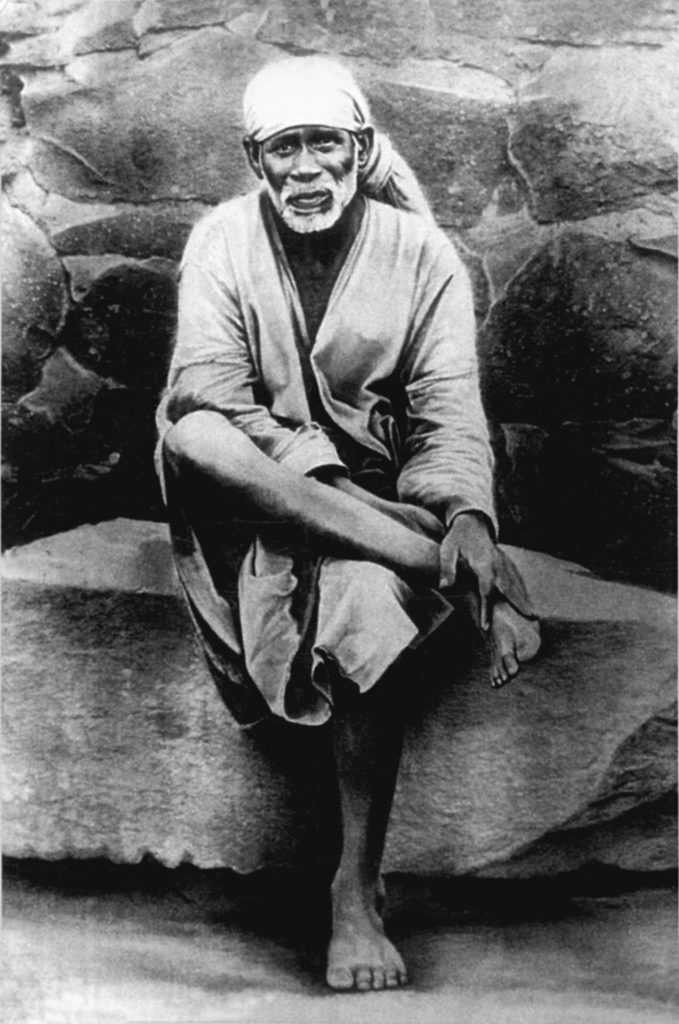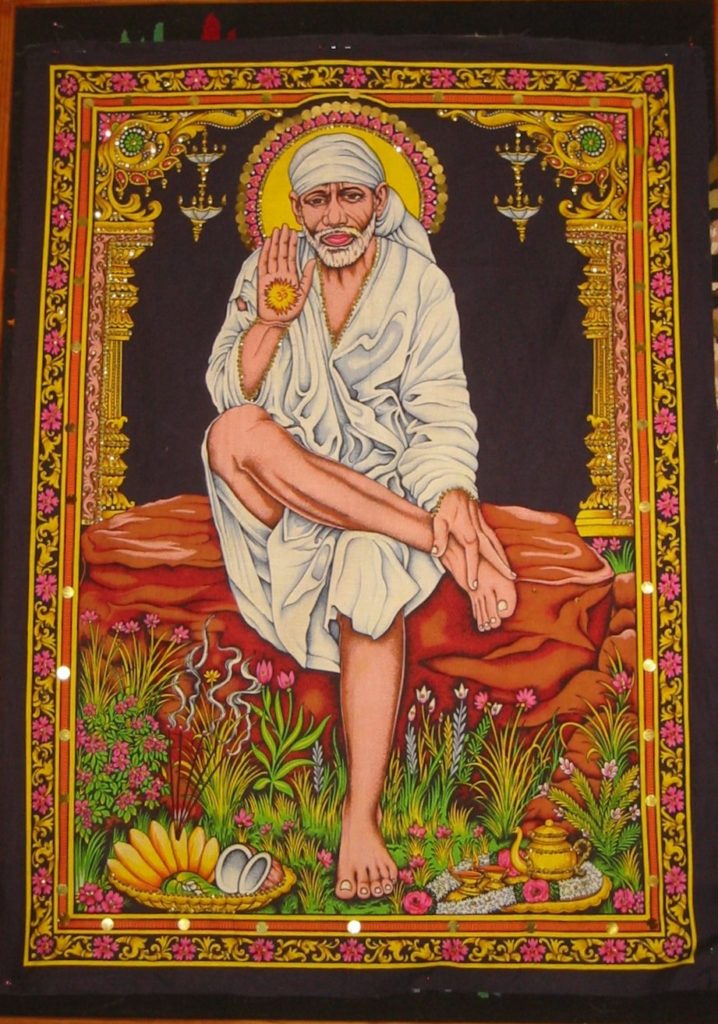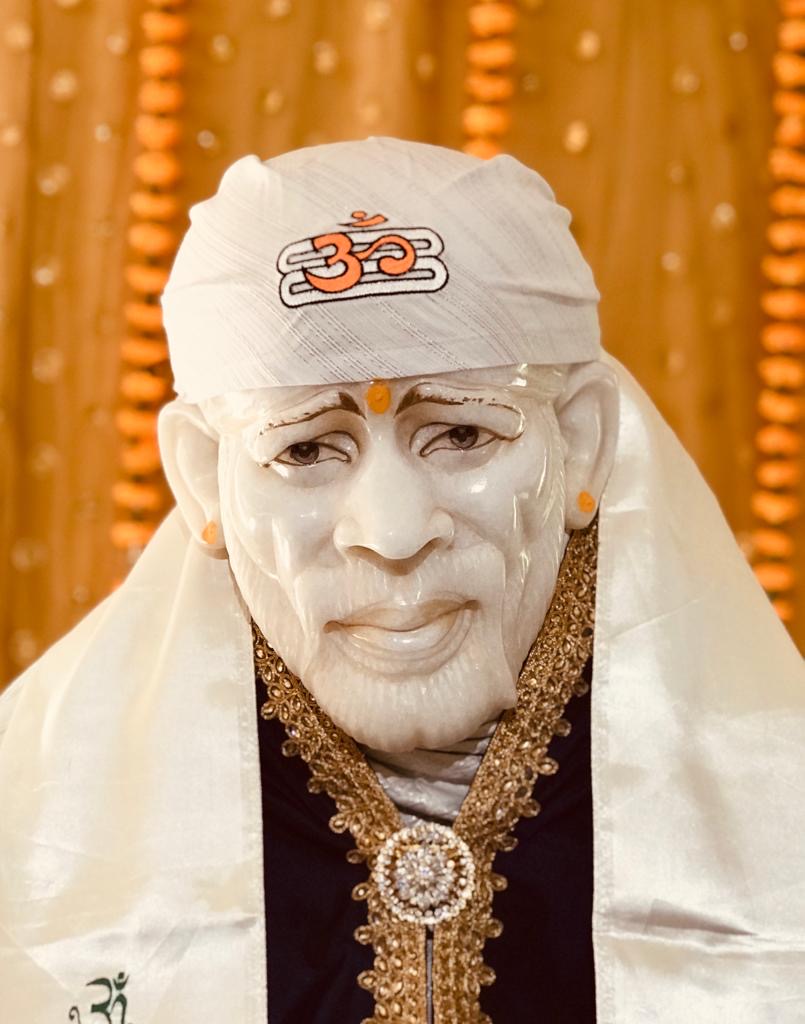Allah Malik = God is the Ruler
Sai Baba of Shirdi was an Indian spiritual Master considered to be among the highest category of Yogis and seen as a manifestation/Avatara of Lord Dattatreya. He was equally revered among both Hindus and Muslims and is now worshipped all over the world.
The sacred book about the first incarnation of Lord Dattatreya ‘Sreepada Sreevallabha Charitaamrutam‘ written during his lifetime [1320-1350] prophesied the incarnation of Sai Baba. It claimed him to be an incarnation of Lord Hanuman.
The teachings of Baba were focussed on Devotion, Self-surrender to the Sat-Guru, Service, and Compassion.
Sai Baba’s actual name remains unknown, and no documented evidence regarding his birth and parents exists. He first showed up as a young lad of sixteen years sitting under a Neem tree in Shirdi. When the young Fakir returned to Shirdi after a short absence, he was welcomed with the words ‘Ya Sai’ [Welcome Sai], after which people started calling him ‘Sai Baba.’ Sai Baba stayed in Shirdi initially for three years, following which he disappeared and returned in the year 1858. He led a strict, ascetic life sitting under a Neem tree, meditating with total indifference to cold, heat, or rain. Later he moved to a dilapidated mosque.
Sai Satcharitra, the life story of Sai Baba written by his disciple Hemadpant, focuses on the relationship between Guru and disciple and the glory and importance of the Guru principle. Sai Baba is considered as Samartha Sat-Guru, meaning ‘the Competent Master.’ Sai Baba insisted on complete self-surrender to Guru as the definite path to Enlightenment. He strictly followed his own Master Venkusa for twelve years, during which he was rigorously trained, following which he attained self-realisation.
Why did Hemadpant write the biography of Sai Baba? In his words, the answer is plain and simple. ‘The life of Sai Baba is as wide and deep as the infinite ocean, and all can dive deep into the same and take out precious gems of Divine Knowledge and Devotion [Bhakti], and distribute them to the aspiring public. The stories, parables, and teachings of Sai Baba are wonderful. They will give peace and happiness to the people afflicted with sorrows and are heavily loaded with miseries of this worldly existence. They bestow knowledge and wisdom, both in the worldly and spiritual domains. If these teachings of Sai Baba, which are as interesting and instructive as the Vedic lore, are listened to and meditated upon, devotees will get what they long for, whether it is union with Brahman, mastery in eight-fold Yoga, Bliss of Meditation, etc. So I considered that calling these stories together would be my best Upasana [devotional service]. This collection would be most delightful for those simple souls whose eyes were not blessed with Sai Baba’s Darshan. Therefore, I set about collecting Sai Baba’s teachings and expressions – the outcome of His boundless and natural Self-Realisation. Sai Baba inspired me in this matter; in fact, I surrendered my ego at His feet and thought that my path was clear; and that He would make me quite happy here and in the next world.’
Sai Baba always condemned discrimination based on caste or religion. His teachings had elements of both Hinduism and Islam. He gave the name DWARAKA MAI to the Mosque in which he lived. Many devotees experienced miracles under Baba. He cured incurable diseases in miraculous ways, and many visitors had higher spiritual experiences under his guidance.
On the 15th October of 1918, Baba entered his Mahasamadhi; the place where His body is kept is now called Samadhi Mandir. Baba promised his devotees that he would continue to work from his Samadhi itself. Millions of devotees visit the holy place of Shirdi each year as it has become one of the biggest pilgrimages in India.
His famous quotes are :
Sabka Malik Ek = Every One’s Master is One
Shraddha and Saburi = Faith and Perseverance
Allah Malik = God is the Ruler
Allah Bhala Karega = God will do Good

There is no documented evidence regarding Sai Baba’s birth or his parents. Few close associates claimed that he was born of Deshastha Brahmin parents in the village of Pathri and was entrusted into the care of a Fakir in his infancy.
Whenever someone asked him regarding his birth, he would answer that it was unimportant and used to give vague answers.
In the middle of the 19th century, when Sai Baba arrived, Shirdi was a very small and insignificant village in Maharashtra, unknown to most people. It is in the district of Ahmednagar. One has to cross the Godavari river at a place called Kopargaon before reaching Shirdi. For some inexplicable reason known only to himself, this was the place chosen by the great Saint to make his appearance. Today it has become a flourishing town attracting millions of devotees from all over the world because it was on this blessed spot that Sai Baba played his immortal ‘lilas’ [divine plays].
The life of Shirdi Sai Baba is remarkable in as much as nobody knows his parentage, name, birthplace, or caste. Many people asked him these questions, but he always parried them and refused to answer any question regarding his personal life. He revealed himself under a neem (margosa) tree just outside the village. He appeared to be about fourteen years of age and was sitting and practising meditation under the tree for days, without caring for the heat or cold or rain. The simple folk pestered him with questions, but all he said was that it was under this tree that his Guru had practiced penance. After this, the boy disappeared for some years.
His next appearance was with a marriage party that arrived in the village of Shirdi from the town of Dhoop. The marriage party was led by a Muslim called Chand Patil. This man had lost his horse on one of his journeys, and though he searched everywhere, he couldn’t find it. As he was walking back dejectedly, he saw a fakir (holy man) sitting under a mango tree. The fakir beckoned to Chand Patil who went near and saw that he was preparing to smoke a chillum (a kind of pipe). He asked Chand Patil what he was looking for, and when he heard about the lost horse, he advised him to search near the creek. To his amazement, Chand Patil found the horse quietly grazing at the exact spot pointed out by the fakir.
He realised that the man was not an ordinary person. When he returned to the fakir [Sai Baba], the latter was just about to smoke his pipe, but he had neither of the two things necessary to light it. There was no fire and no water to wet the cloth to put over the pipe. The fakir casually took his stick and thrust it into the earth and came out with a live ember, which he put into his pipe. Then he dashed his stick on the ground, and immediately water started to trickle out. The Fakir prepared the pipe, drew hard at it, and handed it over to the astonished Chand Patil. The latter now invited him to go and stay in his house. This invitation was accepted, and in a few days, when Chand Patil’s marriage party set out to Shirdi, the fakir also accompanied him.
When the marriage party came to the outskirts of Shirdi, it stopped just outside the temple of Khandoba. A person called Mahalsapati was the priest of this temple; when he saw the young fakir, he was so struck by his looks that he addressed him as ‘Ya Sai’ (Welcome Sai). This name stuck to him, and ever since, people started addressing him as Sai Baba. Nobody knew his real name if he had one. From that day onwards, Sai Baba lived in Shirdi till his Mahasamadhi in October 1918. He lived all his life in a broken down masjid or deserted mosque, which he called Dwarakamai. He kept a dhuni or sacred fire burning all day and night and distributed the ashes from this to people with his blessings. This ash had miraculous powers, and even today, it is capable of curing all ailments. Today Shirdi has become a bustling town to which hundreds of people come to worship at the shrine which contains the mortal remains of the great Saint. He had prophesied that his tomb would speak, and anyone who came there would be blessed. And so it has come to pass.
Baba used to speak highly about his Guru Venkusa under whom he practiced for twelve years. Baba considered his master Venkusa to be his mother, father and guide, and everything. His Guru was the sole object of meditation and worship for Baba during that period. His Master, Venkusa, exposed him to rigorous training.
Baba had complete knowledge of the past, present, and future. He could communicate and understand the language of every creature. He could cure many medically incurable diseases and even prevented a Cholera epidemic in the village of Shirdi.
Baba insisted on continuous remembrance of God or Sat-Guru for his devotees to become free of the clutches of Maya (illusion). Baba allowed his devotees to worship him as they liked. Baba used to say that nobody can enter Dwarakamai without Divine Will, and even more, that Baba doesn’t take money as Dakshina from anyone without some Divine Purpose. He used to roam in forests at noon and be in a state of ecstasy during meditation. A lady named Bayaja Bai used to search for Baba in the dense forest walking over bushes and shrubs in the afternoon and placing a leaf in front of him, and arrange food for him. Baba was extremely pleased with her service. Later, Baba stopped going into the forest and had his lunch in Masjid/ Dwarakamai itself.
SAMADHI OF 72 HOURS
In the year 1886, on a full moon day, Baba had a severe attack of asthma. Baba asked Mhalsapati to protect his body for three days, and if he did not return, Baba ordered his body to be buried in the nearby open land. By 10 pm, his breathing and pulse stopped. All villagers gathered, and many wanted to bury the body, but Mhalsapati resisted. After three days, at 3 am, Baba opened his eyes, and his breathing continued as normal.
DEPARTURE
Baba had a brick on which he rested his hands and even leaned on during the night. One day, a boy, while sweeping the floor, accidentally slipped and broke it into two pieces. Baba cried and said, ‘It is not the brick, but it is my fate, which split into two parts.‘ Nobody understood what it implied until Baba left his mortal frame just a few days later.
Just before leaving his physical body, Baba gave Rs/-9 to Lakshmi Bai Shinde, which is symbolic of nine forms of Bhakti.
Before his departure, Baba informed Ramachandra Patil that Tatya Patil, who was seriously ill at that time, was going to die on the day of Vijaya Dasami, but Baba himself died as if it was an exchange of karma.
On Tuesday, 15th October 1918, at 2:30 pm, Baba entered Mahasamadhi. On Wednesday morning, he appeared in the dream of his devotee Lakshman Mama Joshi and informed her, ‘Get up soon, do your worship and Morning Arati.‘
On Wednesday evening, his body was placed in Wade’s centre (Garbha), which was actually planned to be the place for the idol of Muralidhar (Lord Krishna).
Before his death, Baba promised to continue his work from his Samadhi and continue to guide his devotees. Today Baba is more active than ever, and many stories are told about his ongoing miracles and blessings.

SWAMI SAMARTH OF AKKALKOT AND SHIRDI SAI BABA, ONE CONSCIOUSNESS
Swami Samarth’s connection with Sai Baba, both from the same lineage, is from the Dattatreya Tradition. When Swami Samarth left his body, a part of his soul merged with Sai Baba, and Sai Baba became more powerful. So Swami’s presence started spreading further. Akkalkot Swami’s presence is very, very powerful even now. Those who connect to Swami will know. After he attained Mahasamadhi, some of his devotees were coming to Akkalkot. Swami came into their dreams and said, ‘Go to Shirdi; I am sitting there.‘ When they came to Shirdi and looked at Sai Baba, they could see Akkalkot Swami also. So Masters are all one; it’s one Consciousness, operating in different bodies.
Sai Baba’s teachings revolved around devotion, universal love, compassion, and selfless service. Sai Baba insisted on the importance of the Sat-Guru, and complete surrender and devotion to the Sat-Guru. Baba used to collect Dakshina [devotional offering] from his devotees to inculcate the spirit of service. He taught humanity that He resides in every creature, and that service of any creature verily reaches Him.
Baba advised Hindus to read Bhagavad Gita and Muslims to read the Quran. He advised many devotees to do Naam Saptah, chanting the name of God or Saint continuously for seven days. For a few, Baba advised reading Vishnu Sahasranama. A pillar of his teaching is that Faith and Perseverance are crucial for the spiritual aspirant.
Baba’s core tenets were staunch faith and obedience to one’s spiritual Master, and strictly abiding by his orders as a definite way to Self-Realisation.
Baba severely condemned any discrimination based on caste or religion and advised people to see one’s Self in every being. Baba taught devotees to drop their ego of doership and told them that God alone is the doer.
BABA’S ELEVEN PROMISES
QUOTES OF SAI BABA FROM SRI SAI SATCHARITA
HOLY DAYS
Sai Baba took Samadhi on the 15th of October, 1918, on the day of the Hindu festival Dussehra and is now observed as a holy day by all Baba’s devotees.
Sai Baba used to celebrate the Muslim festival Urus along with the Hindu festival Ram Navami.
HOW TO INTENSIFY DEVOTION
The best way to intensify devotion is to read the Lord’s leelas [divine plays] and continuously chant his holy name.
SPIRITUAL PRACTICES AND MANTRA
Baba never gave his devotees mantras, but he advised his devotees to utter his name ‘Sai, Sai.’
For a few devotees, Baba used to advise Vishnu Sahasranama [repetition of the holy names of Vishnu].
For a few other devotees, Baba advised doing Naam Saptah [continuous chanting for seven days] of Rama Nama.
Baba taught his devotees that God pervades everywhere and resides in every creature. Baba advised practicing Anna Dana (food donation).
Baba advised strict obedience to one’s spiritual master as a key to spiritual success.
INSTRUCTIONS OF BABA TO DEVOTEES

Once Baba, along with some devotees, was sitting in the Masjid when a lizard tick-ticked. Baba said that the lizard was overjoyed as her sister from Aurangabad was coming to meet her. Devotees couldn’t comprehend this statement. Immediately a gentleman from Aurangabad arrived on horse-back to meet Baba. A lizard jumped from a bag of grains, and in front of everyone, climbed the wall. When the two lizards saw each other, they kissed and danced with love. Everyone who witnessed was spellbound!
When Kashinath [Upasani Maharaj] was cooking food for Sai Baba, a black dog was watching. Kashinath did not bother to offer food to the dog. When he took the food all the way to Baba, the dog followed him. When he offered the food to Baba, Baba replied, ‘Why did you take the trouble to bring food to me? I was there just near you‘ Kashinath said that no one had been beside him except a black dog, and Baba replied, ‘Yes, yes, I was the dog who came to you.‘
The next day when Kashinath was again cooking for Baba, a low caste Shudra came up to him, begging for food. Kashinath sent him off and came to Baba with the food. Baba replied, ‘Yesterday, you did not give me food. Today also, you did not feed me. Do not bring me any food hereafter.‘ Baba told him that it was He who had come as Shudra.
Then Upasani realised that Baba pervades every creature.

For contemporary manifestations of Sai Baba please see the following books:
Shirdi ( Maharashtra, India)
What to look for in Shirdi
Sai Baba Temple, Trichy, Tamil Nadu. This temple is the biggest temple of Sai Baba in Asia.
Devotees can read Shri Sai Satcharita online at the following websites
www.saidhamsola.org
To read Sai Satcharita in regional languages, devotees can refer to this website
www.sai.org.in
The list of books given below would help the devotees for further reading.
SAI BABA REVEALS HIMSELF AS AN AVATAR OF LORD DATTATREYA
In a miraculous vision, Sai Baba Himself revealed that He is none other than an Avatar of Lord Dattatreya. Guruji Pujya Dharamdas Baba, an enlightened mystic, shares his divine experience. He takes us through his private journey toward Shirdi Sai Baba in a lyrical and spellbinding way.
© MyDattatreya 2021 All rights reserved
Designed by Tamara Lj.